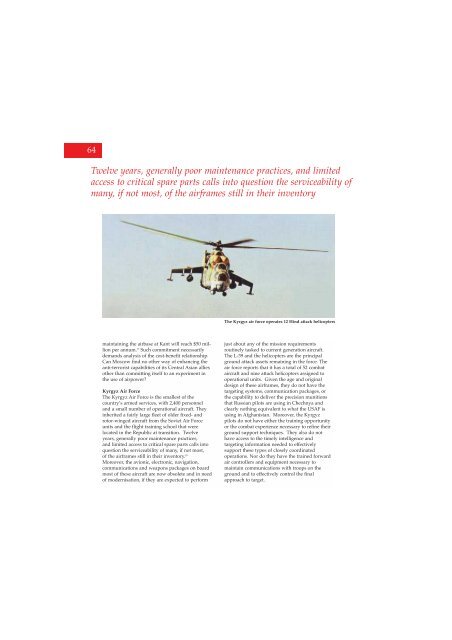Volume 6 No 4 - Royal Air Force Centre for Air Power Studies
Volume 6 No 4 - Royal Air Force Centre for Air Power Studies
Volume 6 No 4 - Royal Air Force Centre for Air Power Studies
You also want an ePaper? Increase the reach of your titles
YUMPU automatically turns print PDFs into web optimized ePapers that Google loves.
64<br />
Twelve years, generally poor maintenance practices, and limited<br />
access to critical spare parts calls into question the serviceability of<br />
many, if not most, of the airframes still in their inventory<br />
The Kyrgyz air <strong>for</strong>ce operates 12 Hind attack helicopters<br />
maintaining the airbase at Kant will reach $50 million<br />
per annum. 17 Such commitment necessarily<br />
demands analysis of the cost-benefit relationship.<br />
Can Moscow find no other way of enhancing the<br />
anti-terrorist capabilities of its Central Asian allies<br />
other than committing itself to an experiment in<br />
the use of airpower?<br />
Kyrgyz <strong>Air</strong> <strong>Force</strong><br />
The Kyrgyz <strong>Air</strong> <strong>Force</strong> is the smallest of the<br />
country’s armed services, with 2,400 personnel<br />
and a small number of operational aircraft. They<br />
inherited a fairly large fleet of older fixed- and<br />
rotor-winged aircraft from the Soviet <strong>Air</strong> <strong>Force</strong><br />
units and the flight training school that were<br />
located in the Republic at transition. Twelve<br />
years, generally poor maintenance practices,<br />
and limited access to critical spare parts calls into<br />
question the serviceability of many, if not most,<br />
of the airframes still in their inventory. 18<br />
Moreover, the avionic, electronic, navigation,<br />
communications and weapons packages on board<br />
most of these aircraft are now obsolete and in need<br />
of modernisation, if they are expected to per<strong>for</strong>m<br />
just about any of the mission requirements<br />
routinely tasked to current generation aircraft.<br />
The L-39 and the helicopters are the principal<br />
ground attack assets remaining in the <strong>for</strong>ce. The<br />
air <strong>for</strong>ce reports that it has a total of 52 combat<br />
aircraft and nine attack helicopters assigned to<br />
operational units. Given the age and original<br />
design of these airframes, they do not have the<br />
targeting systems, communication packages, or<br />
the capability to deliver the precision munitions<br />
that Russian pilots are using in Chechnya and<br />
clearly nothing equivalent to what the USAF is<br />
using in Afghanistan. Moreover, the Kyrgyz<br />
pilots do not have either the training opportunity<br />
or the combat experience necessary to refine their<br />
ground support techniques. They also do not<br />
have access to the timely intelligence and<br />
targeting in<strong>for</strong>mation needed to effectively<br />
support these types of closely coordinated<br />
operations. <strong>No</strong>r do they have the trained <strong>for</strong>ward<br />
air controllers and equipment necessary to<br />
maintain communications with troops on the<br />
ground and to effectively control the final<br />
approach to target.
















